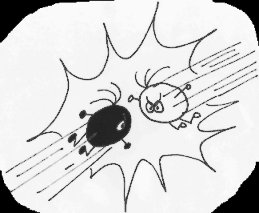

Back in time to the Big Bang (cont.)
Ellen Ten billionths
of a second after the Big Bang, the entire Universe would have fitted
into your living room. Inside, energy and matter were completely exchangeable
- the temperature was billions of billions of billion degrees. New particles
and antiparticles were created all the time - and then annihilated back
into energy.
Tim So - at that time there were still equal amounts of
matter and antimatter?
Ellen No, the symmetry between matter and antimatter was
already broken. We don't yet understand why. Somehow a small surplus of
matter appeared: for every billion antimatter particles, there were a
billion plus one matter particles.
Tim The Universe got a kick which made it tip to the 'matter
side'! Where did all the antimatter go?
Ellen The antimatter part of the Universe was doomed - it
took only about a second to wipe it all out. While expanding, the temperature
in the Universe continued to drop rapidly. Particles and antiparticles
annihilated in pairs. But after one second, the temperature had dropped
too low to create new particle-antiparticle pairs. Only the small amount
of 'leftover' matter particles remained - the rest had disappeared into
radiation.
Tim Pheww! So without that tiny surplus of matter there would be
no stars, no planets, no humans? The universe would consist only of light
in an empty space?
Ellen Yes, it seems that
we owe our existence to a very small asymmetry between matter and antimatter.
That's why physicists are trying to find out more about antimatter. But
did you know that we still observe the echo of this battle between matter
and antimatter? The radiation produced in the annihilations is called
the 'Cosmic Background Radiation', and it fills the whole Universe uniformly.
I will show you a picture of it at our next stop.

